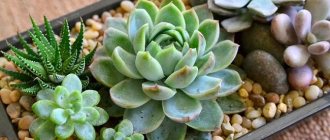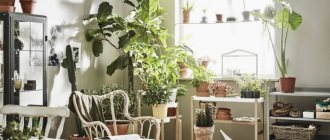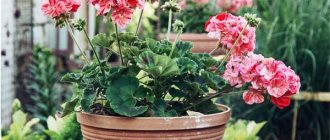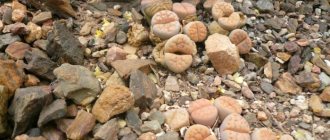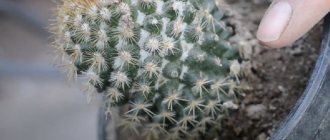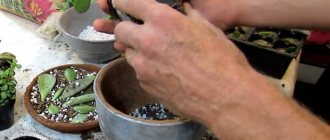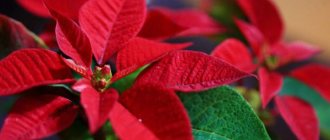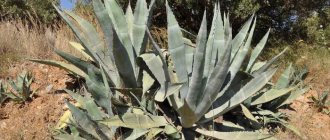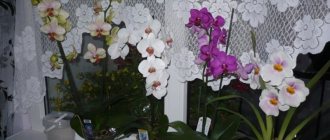Succulents are a real boon for compositions and creativity; they can be planted not only in shells, driftwood, coconut shells, cups, cracks on the walls, but also in anything your imagination suggests. Of course, we wouldn’t want to limit it, so here we will present only what will really be useful and will help you create your own unique composition with your own hands. The article is mostly a selection of photos, but there are also several universal master classes that will allow you to quickly master the main rules for designing compositions from succulents.
Let's start with the assortment
Let us describe groups of suitable plants and some specific “heroes”. Of course, the entire set of cultures cannot be covered in one article:
- Cacti. But not all of them are suitable for compositions.
- Aloe, various forms.
- Lithops (they are rarely used in compositions with other plants, because the agricultural technology of these plants is very peculiar). As a rule, different types of lithops are arranged in one pot, without other plants.
The most popular plants in compositions:
- Sedums.
- Rejuvenated.
- Aeoniums.
- Echeveria.
Sedums are a huge group of plants. In the photo below, on the left, there is a prominent sedum - plants 30-40 cm high, with bright decorative flowers, on the right - blue sedum - its height does not exceed 5-10 cm:
Young - well known under the name “stone rose” also includes a lot of hybrids:
Aeoniums are plants 25-30 cm high. There are many varieties and varieties:
Aeonium Arborium 'Schwarzkopf'
Aeonium Haworthii Variegta
Echeverias are very popular for creating continuous surfaces, especially flowing effects:
There are many varieties of echeveria. They are actively used for wall planters:
Miniature finestraria with cone-shaped leaves are good for tabletop compositions. Their agricultural technology is similar to that of Lithops: complete absence of watering in winter, careful and meager watering in summer, well-lit place.
Fenestraria Rhopalophylla
Finestraria with lithops.
Ampelous succulents
Rowley's ragwort - original ball leaves. Unpretentious.
Morgan's sedum is a fairly powerful plant with long stems densely covered with leaves. Hanging shoots resemble thick sausages.
Of course, the plant is highly decorative and solo, but it is also actively used in compositions. True, in the photo below there is a Burito sedum very similar to it:
Sedum Burrito:
Sedum Burrito
It is also worth looking at other representatives of the Crassulaceae family: cotyledons, pachyphytums, Kalanchoe, sedums, crassulas, graptopetalums . From other families, the following are suitable: euphorbia, peperomia, senecio, some species of agaves, haworthia, gasteria , representatives of the families Mesembryanthemum and Lastovnevye . Euphorbiaceae family may be suitable .
It makes sense to try your hand at arranging individually planted plants first:
What is a florarium with succulents?
First, let’s take a closer look at what a florarium is. In essence, it is a small container that is made of glass or plastic and filled with plants, pebbles, and shells. Sometimes they are illuminated to admire the “garden in a bottle” even at night.
A florarium is a kind of aquarium or terrarium, but only for plants. Water is not poured there, but ideal conditions are created for the mini-plants placed inside. A lid is placed on the container, thanks to which a certain microclimate is created inside the bottle, suitable for cacti, orchids, mosses, etc. placed in it.
The first florarium is considered to be the “Ward's box”, which was made by the British scientist Nathaniel Ward back in the 18th century. He placed plants from the tropics in a special box, bringing the microclimate in it closer to the one to which they were accustomed.
Not only bottle gardens, but also greenhouses originate from the “Ward’s box,” since after its creation people began to import plants from warm countries and make winter gardens. But not everyone could afford to make a greenhouse in their home, and a small florarium was accessible to almost anyone. After all, it will not take up much space and will fit perfectly on a table, shelf or windowsill.
The main thing is to create a microclimate for the plants placed in the terrarium , which is not too difficult. Small house plants are planted in such a way that the soil does not have to be changed. Thanks to this approach, a closed ecosystem is created and the owners of bottle gardens admire these small masterpieces for a long time.
There are three types of florariums:
- aquarium type, created in ordinary aquariums;
- created in special vases, glasses and jars;
- bottles, in which plants are planted through a narrow neck.
The latest florariums are, of course, the most unusual and spectacular. But creating such small masterpieces and caring for them is not easy. The easiest way to make an aquarium florarium, especially since when purchasing an aquarium, the kit includes a backlight and a lid.
Sequence of composition creation
Regardless of the size and shape of the composition, there are general rules for their creation:
- The base container is manufactured. It could be anything. If the composition is flat, a wooden box will do. Soil is laid in layers (universal soil half diluted with perlite is suitable), then a layer of moss.
- A metal mesh will be needed on top; it will allow you to hold the soil if the composition is not a floor one, but, for example, a wall one. Volumetric figures are also created from metal mesh. The mesh can be purchased at construction stores. You can secure it using a construction stapler.
- Seedlings are planted in the holes. You should wait several weeks (at least two) until the seedlings are well established and grow into the ground.
- The composition can be placed in the desired position.
- Watering is not necessary because succulents do not like dampness, but periodic spraying or spot watering will be required.
Now you know how to make almost any composition from succulents. Of course, this is a very simplified scheme, because such important things as the thickness of the soil layer, the mixing of the earth mixture, the selection of moss and decor, that is, in fact, everything that creates conditions for plant roots, are selected individually for each composition - one might say , "approximately". However, the aim is formed quite accurately with experience in growing succulents. If you have been seriously studying them for at least a year, feel their needs, know how to grow a healthy plant, where to put it, what to plant it in, how to water it, then there will be no problems with creating your own masterpiece mix.
How to make a florarium with succulents and care for it correctly?
Even if you have little free time, a florarium is a great opportunity to have a beautiful corner of nature at home. Caring for it will not take much effort.
Where to place it . It is important to choose the right place for a mani garden. In summer it will be better if it is located in the north side, and in winter it is advisable to move the small greenhouse to the windowsill, closer to the sun, but away from the radiators.
What kind of lighting is needed ? When creating a florarium, it is advisable to equip it with lighting so that the plants receive the necessary amount of light. If there is no such illumination, all conditions are created so that they receive the maximum amount of daylight, but at the same time they are not burned by the sun's rays.
Optimal temperature a. For a bottle garden, the room temperature is set to 22 to 28 degrees. Plants are thermophilic and do not tolerate cold. But the heat is not for them either. So it’s better to stick to the “golden mean” of 24-25 degrees.
Watering and humidity . It is enough to water the plants in a bottle garden once a week or even two. At the same time, avoid overfilling. Water the plants as follows: pour 1-2 teaspoons of water under the roots, trying not to get on the leaves. It is important to ventilate the florarium in a timely manner and wipe the walls from dust. Then your small garden will live for more than one year.
Fertilizers . A small greenhouse does not need fertilizer. With constant care, she will live for several years. Fertilizers activate plant growth, which is completely unnecessary in a mini-greenhouse. In addition, there is a risk of salt accumulation in the soil, which is harmful for small plants. But when the leaves turn yellow, adding very little fertilizer is acceptable.
Container selection
We decided not to waste printed signs, but simply show you as many different containers as possible. It is noteworthy that succulents can get by with a small amount of soil, so even the smallest objects can act as a container.
You can implement any image using:
Shells
Or their imitation from gypsum or cement:
The photo shows a cement sink made specifically for the composition.
Treated wood
It is better, of course, to use wooden containers as flowerpots, and plant the plants in a container that is less exposed to moisture.
Stumps and snags
A charming and very skillfully executed composition with shells.
Toys
Old pots and vases
And the more holey, the better:
Everything you can find in the kitchen
Cups, spoons, scoops for bulk products, baking dishes, beautifully decorated old tin cans, cups, out of order teapots, sardine cans, picnic baskets, candy dishes and dessert dishes:
Vintage of old cans, watering cans, plastic bottles, as in some of the photos above, is a separate process, no less interesting than creating compositions from succulents. It is noteworthy that none of the domestic craftswomen has yet mastered such processing of junk. Many of the arrangements pictured above in recycled vintage containers are commercial arrangements intended for sale. However, they are not much different from amateur ones made by hand, except that on the fly you can hone and simplify the details.
Chairs
There is something nostalgic in such compositions, where succulents tightly cover the chair and it’s not even about the style of the piece of furniture itself. The very fact that the furniture is completely overgrown with plants evokes associations with an abandoned garden and the romance of antiquity.
And even wine corks or eggshells
And in general - any items
Creating a florarium in improvised containers step by step
Let's look at how to create a florarium with your own hands step by step. Every house has old sets and other unnecessary glass containers. You can take them for free from relatives, or buy them for practically nothing at flea markets. There are also old flowerpots in all houses, but they look unattractive. If you choose the least whimsical and low-growing ones, it is quite possible to create original florariums with your own hands. You will find the necessary tools, supplies and home decor. All that remains is to allocate a little time.
- Take suitable containers, remove all labels, remaining glue, dirt, wash with warm soapy water and wipe dry. Immediately think about how you want to arrange the plants in them. Just don’t take plexiglass, it gets scratched and becomes cloudy. It is also not recommended to use wood; it does not like moisture.
- Place a drainage layer of pebbles, small stones, and sand so that the water settles and does not flood the crops. Rinse it first by treating it with boiling water and drying it. The layer should be 3-4 centimeters.
- Take charcoal (both charcoal and activated charcoal will do). Its layer should be 1 centimeter. It will destroy odors, bacteria, fungus, chemicals. By the way, use only filtered water for irrigation, or better yet, drinking water, which definitely does not contain harmful substances.
Did you know about the interesting uses of coal? It is used to whiten teeth, as a deodorant for shoes, to get rid of oily hair, as an air freshener after soaking in essential oil, and to make explosives.
- Lay out the substrate. A light sandy mixture is suitable for succulents; flower soil is suitable for the rest. The layer should be the same height as the pot in which the plant was located so that the roots have enough space for further growth. For tanks with a volume of 1 - 1.5 liters, this is a layer of about 6 cm.
- Remove the flower from the pot and beat the hard ball of soil until the roots come out clean. Be careful not to damage them. If they turn out to be too long, cut them off and then they will grow back. If you work with cacti, be sure to wear gloves.
- Using a regular spoon, spatula, or other available tools, make a hole to place the plant roots. Add more soil at the top and firm it around the base of the plant.
- When you finish planting, add decor that suits the design: moss (dried or live), figurines of birds, animals, insects, toys (dolls, cars), old beads, any bright, shiny, interesting objects, sticks, driftwood, stones. Use your imagination, but check whether additional accessories will interfere with the growth of crops.
- Wipe the container so that there is no soil left on it, and then water the mini-garden a little. A few injections will be enough. In the future, this should be done once a week in the summer, and once a month in the winter. That's the whole master class, the florarium is ready. All that remains is to admire it. Avoid direct sunlight on the product, otherwise it will burn. If any leaves turn yellow, remove them immediately so that other crops do not suffer.
Step-by-step instructions will help everyone to create a florarium with their own hands. But this option is only suitable for a home garden. If you need a solid mini-greenhouse as a gift for friends, colleagues or the office, it is better to buy a florarium in our online store. We are located in Moscow, but we deliver orders throughout the Moscow region and throughout Russia.
Images
This is also purely a matter of imagination, so below are some photos for inspiration.
Landscapes with mountains and rocks
Below we will talk more about landscapes, only more complex. Recreating mountains, cliffs, islands lost in the white foam of sea waves is relatively easy to achieve. Use decorative stone chips, marbles, stones, driftwood, cobblestones, and their plaster imitations.
Stream or waterfall
The technique is quite popular - plants or stones imitate spilling water. This technique is often used in open ground flower beds, using ground cover flowers (pansies, ageratum, soapwort, aubrieta, arabis). Succulents will successfully cope with the same task. Blue-gray echeverias are ideal.
However, nothing prevents the spilled “waves” from being of a different shade:
Succulents can be an excellent addition to a stone stream:
Animals
Ball and other three-dimensional hanging figures
This is a more difficult task. Ready-made succulent balls cost about 50 Euros on Etsy.
A ball is made from wire with a diameter of..., wrapped with the same mesh, but not completely, a little space should be left so that you can work with the inner surface of the ball. to lay out the surface with a very thick layer of moss and coconut fiber, then fill it with soil suitable for succulents, perhaps looser; a small diameter foam ball can be inserted into the center to prevent dampness and not make the composition too heavy. Close the grid. You can start planting plants.
Trees are created using the same principle.
Panels, paintings and other wall compositions
For Valentine's Day:
Inscriptions and signs
The price of such an original pointer is about $30.
Nothing prevents you from posting any inscription using the same principle.
Wreaths on the door
They are not very popular here, although I must admit that a wreath, including one made of succulents, on a door or on a fence, looks attractive.
Panel from Ikea table
A quite popular online master class on making a composition from a table purchased at Ikea. It is worth noting that the idea is indeed successful and looks stylish.
Imitation of landscapes and landscapes
The use of houses, stones imitating rocks, and miniature bridges makes compositions with succulents charming, but you should not take on such a composition without experience - trial options can be so far from the desired image that disappointment cannot be avoided. In addition to a carefully thought-out composition, preferably in advance and on paper, you will need to spend money on high-quality decor, or find natural materials for it, in addition, you should be well acquainted with the selected succulents.
Simpler in terms of planting are houses with overgrown roofs:
Just below, in a picnic basket, is a village landscape made by a Japanese craftswoman for sale. You can see how finely the details are worked out:
Aquariums and gardens in a bank
Succulents and cacti are great for glass arrangements, despite the criticism. Particular attention should be paid to good drainage, because a glass container for succulents will be too humid, and lighting - because even ordinary glass absorbs light.
Caring for a garden in a jar means periodic spraying, and, of course, it is worth making sure that the room where it is located has clean, fresh air without dust.
And one more important point - the vessel should not be closed.
Petr Lapshin, curator of the collection of succulents at the Institute of Fracture of the Russian Academy of Sciences, harshly criticizes florariums and notes that succulents are completely unsuitable for growing in glass vessels. Let us not allow ourselves to agree with him on everything. Closed glass containers are really not suitable for succulents. However, now there are many vessels that are no less spectacular than closed ones, allowing you to provide succulents with suitable conditions for them, namely:
- Mandatory periodic drying of the soil.
- Good lighting.
In addition, it is worth noting that such compositions are designed to provide pleasure, and it does not have to be long-lasting. This composition is a good way of self-expression, an excellent gift or temporary interior decor. In a few months, plants, even succulents and even in conditions suitable for them, grow and the composition loses its appearance - it has fulfilled its functions, the plants can be planted in other containers, and a new composition can be created in the vessel.
You can use decorative sand
This sand is sold, for example, in the Fix Price network, or in stores for florists.
Options with sand are simple, they do not require a complex arrangement of plants, but in general, compositions “behind glass” are quite complex from a compositional point of view.
How to arrange beautiful succulents, how to combine them? There is a class of people who are able to beautifully compose any form without special training; if you are not one of them, then it makes sense to turn to literature. It is impossible to outline the basics of composition within the framework of this article, so we will simply recommend what to read:
- David Hession: everything about flower arranging - inexpensive and accessible. The book is focused specifically on arranging cut flowers and dried flowers, but the general principles of arranging shapes and lines can be mastered.
- From foreign ones exactly on the topic are books by Deborah Lee Baldwin. All about compositions made from succulents. However, they have not been translated into Russian.
Homemade florarium
Once you have decided on the composition of the plants, you can think about what soil to plant them in. The composition of the soil itself is selected according to the requirements of the plants. We can only discuss the composition for cacti and succulents: two parts of turf-clay soil, one part each of humus and river sand, you can add more brick chips. Before making a florarium, let's talk about the sequence of layers. You will need to stock up on sufficient materials.
The “assembly” itself takes a few minutes. But before making a florarium, you have to spend a lot of time selecting plants and determining the optimal soil composition
Creating a composition
Determining where to plant plants takes place in two stages. The first is when selecting plants. You imagine what and how it should look. There are several rules when creating a composition:
- If the florarium, garden in a jar or bottle is visible only from one side, we plant taller plants in the background. They can be placed along the back wall. Moreover, an uneven “relief” looks more interesting - plants of different shapes, colors and heights (if there are several of them). Phalaenopsis are ideal candidates for growing in a glass or jar
- If the composition should be viewed from all sides, the tallest plant is in the center, then to the edges - in descending order.
- In small compositions, the principle of the triangle is observed: one plant is tall, about a third of the space is occupied by a plantation of medium height, the rest is low-growing, ground cover.
- For small florariums with flowering plants, it is the flower that usually takes the lead. All other decoration only emphasizes its beauty.
When you have already bought all the plants, before planting, install them first in the soil already poured into the container. It may well turn out that something needs to be moved, swapped, or even removed. This should be done before you begin to remove the plants from the pots.
In pots or in the ground
As we said earlier, you can plant plants in a florarium directly in the ground, or you can leave them in pots. Each option has its own advantages. Plants in pots can be easily removed, moved, and replaced. In this case, minimal damage will be caused to neighboring plants. But then the composition of the soil is generally unimportant - you can simply fill the gap with pebbles, crushed stone, and decorate the top. This option is also good if the plants have different watering and feeding regimes. This can be done in pots.
The process of planting plants in a florarium
The advantage of planting in the ground is the creation of a unified ecosystem. If you decide to plant without pots, carefully remove the plants and remove as much soil from the roots as possible with your hands. Make a hole in the soil of the florarium (using a wire loop, a miniature spatula, or your hands). Size - so that the roots fit freely. You plant the plant, sprinkle it, compact the soil. When everything is planted, water it.
Soil layer by layer
In general, in most cases, the following sequence of layers for a garden in a vase/glass/jar is recommended:
- A layer of stones of the middle fraction. We are usually talking about pebbles - with rounded edges. The thickness of the layer is about 5 cm. The purpose of this layer is clear - excess moisture accumulates in it.
- Charcoal. The carbon serves as a filter that prevents nutrients from leaking out. It is also a kind of flora stabilizer and helps maintain humidity. The thickness of the coal layer is 2 cm or so.
- Next, the actual soil that is suitable for your plants. Its thickness should be sufficient for the existing root system. If you expect plants to grow, you can make it thicker. In any case, after planting the plants, at least 1/3 of the height of the container should remain unoccupied.
One of the options for planting plants in a florarium.
Here, in fact, is the basic composition of the soil for a florarium. But since plants of even the same species feel good in different soils, the layers change. And sometimes even for the sake of appearance. Therefore, there is only one piece of advice worth following: there should be a layer at the bottom where excess moisture can accumulate.
The only thing we don’t recommend is using expanded clay instead of pebbles for the bottom layer or filling it between plants. Despite popular belief, it absorbs moisture. Moreover, it also accumulates salts dissolved in water. After a while, the soil becomes too salty for most plants.
Possible variations of soil laying
What other soil can be used for planting plants in a florarium? Here are the possible variations:
- Instead of one fraction of stones, two can be used. Medium, fine on top, and then coal on top of it.
- Pour sand at the bottom - under the pebbles. This option is good for growing succulents.
- Separate the stones and coal (sometimes you put soil right away) with a garden net with a fine mesh (1 mm), you can use garden spunbond. This barrier will prevent the layers from mixing.
You can use dried sphagnum as a layer - it will stabilize soil moisture - For plants whose root systems require air supply, you can only use pebbles or crushed stone, you can put stones along the edges, pour soil inside, delimiting the layers with a strip of the same spunbond or a mesh.
- You can lay the bark of conifers along the edges - it both stabilizes moisture and acts as an antiseptic, and as a recharge - as it decomposes, nutrients will be washed into the soil. If you break it into small components, you can use it to cover the soil from above.
One important point: if you find pebbles and sand yourself, the materials must be disinfected. They are either calcined in the oven or boiled for half an hour. After boiling, it is dried and only then used. The same must be done with driftwood.
Examples of beautiful compositional solutions
Many of them can be created based on the principles of arranging dried flowers and cut flowers. Consider: shape, color, size . Start creating a composition by varying only one parameter (for example, plants of the same shape and color, but different sizes), and then move on to the rest (plants of different shapes, colors, sizes). The photo shows compositions from simple to complex:
Using marbles.
Living colors
For those who have achieved mastery in both growing succulents and cacti and arranging them, enormous opportunities open up for using these plants as paints. The color and shape of the plant are like brush strokes. Also, some of these compositions resemble knitting using the freeform technique.
How to plant succulents
Such mini-gardens made of cacti and succulents with houses and paths are sold ready-made. But, in my opinion, it is much more interesting to do it yourself:
Photo by Marina Gerchet

